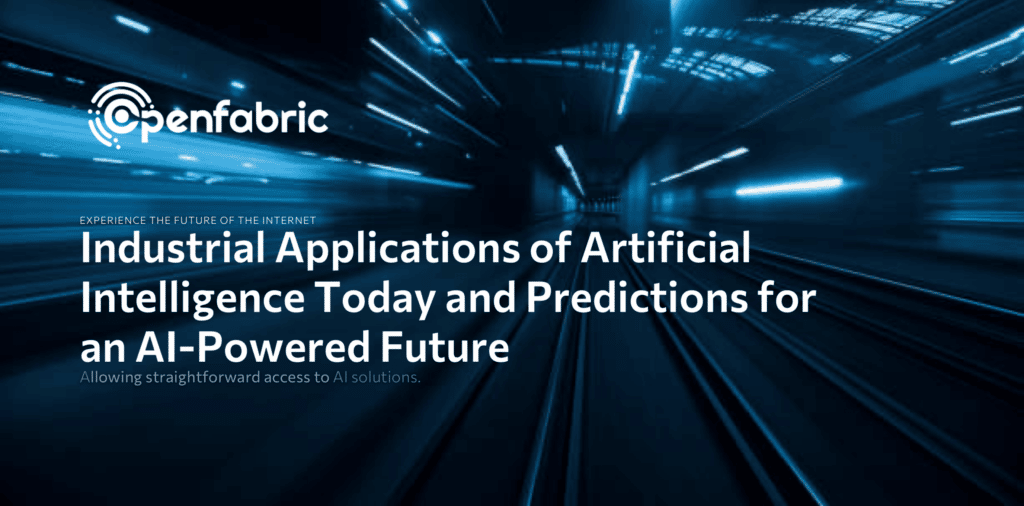
March 17, 2022 6 minutes read
Industrial Applications of Artificial Intelligence

After years of being considered nothing more than science fiction, artificial intelligence (AI) is now a reality. In many cases, it is even a competitive necessity. However, business leaders and decision-makers face a wide range of challenges in finding, implementing, and then scaling the AI tools that provide the right fit and deliver the desired results for different industries, applications, and use cases.
Here we talk about some of the most compelling use cases for AI in the business world. Our goal is to first help appreciate the transformative power of AI and then showcase how different AI applications are being used in the business world in specific areas toward discrete end-goals. We also talk about some of the obstacles standing in the way of AI progress and mass adoption and how the Openfabric model is streamlining and democratizing AI access for users and use cases of all types in a fair, transparent, and cost-effective manner.
Six Benefits of Artificial Intelligence in Business
Consider the following ways AI can help unlock value in different business settings.
- Lower Costs
Low value and/or repetitive tasks such as natural language processing or client scheduling can be automated using AI and intelligent automation solutions to simultaneously lower error rates and improve quality and efficiency.
- Improving the Speed of Execution
Artificial Intelligence solutions that provide predictive insights can reduce latency and the time it takes to, for example, act in response to a predetermined set of events such as requests from employees or vendors or reordering supplies when a certain threshold is met.
- Improving Efficiency
AI can help business leaders better understand the environment in which they are operating using in-depth data and analytics that can drive proactive and predictive decision-making. Examples include ordering new parts before a breakdown occurs or ordering materials when a spike in demand is expected.
- Reimagining Engagement
Better AI helps people interact more naturally with technology. This can help businesses engage with people more effectively without significant investments in human training or process redesign. Examples include chatbots and AI-powered customer service helpdesks.
- Empowering Innovation
AI can help identify market opportunities and risks while highlighting a company’s strengths and weaknesses – all based on historical data – thereby maximizing the chances of success in a given market or campaign. This can help fuel innovation in creating new products, opening new markets, and pivoting to new business models.
- Improving Trust
Real-time Artificial Intelligence solutions can help secure businesses from risks such as fraud and cybercrimes via the implementation of automated safety and security features that can, for example, block a suspicious transaction or flag security personnel when a suspicious event occurs.
Artificial Intelligence in Action
The above provides a clear case for using AI in business. Where do we see it in action today? Here are a few examples from multiple industries, including the fintech, healthcare, manufacturing, customer support, and social sectors.
- AI and machine learning can be used to optimize fleet management and supply routes via, for example, better fleet utilization based on changing market dynamics and customer demand as well as real-time decision-making.
- AI-powered applications can improve customer experiences and can even sense customer sentiment and needs, leading to better and more personalized user engagement.
- AI can help determine optimum stock levels based on sales, margins, and demand.
- Better demand planning and forecasting via better, more accurate consumer demand models, narrowly defined customer segments, and automated decision-making can lead to lower costs and better sales.
- Natural language processing and machine learning can improve contact center experiences, and they can also be combined with virtual assistants and intelligent follow-up with individual users for better overall quality management.
- AI has rich applications in autonomous vehicles and fashion tech (in which AI can determine the best clothing items based on a customer’s tastes, size, and body shape).
- Wearable and non-wearable devices fitted with AI can be used to better monitor health and provide real-time health insights. This can be used in coaching, player load management, injury prevention, medications tracking, and more.
- AI can optimize machine usage and maintenance while predicting failures and breakdowns thanks to asset-level monitoring using IoT devices.
- IoT and AI solutions that use edge devices can streamline production and planning while reducing machine and worker downtime.
The list goes on and on, and it is no wonder that we see so many useful applications for AI – all because of how effective it is in unlocking the value hidden in the vast troves of data that our tech-saturated homes, businesses, cities, and industries generate and gather. From utility management, power planning, supply chain optimization, AI-powered design, fraud detection, customer support, and risk assessment, to using AI to predict food insecurity, addiction, mental health breakdowns, expediting medical trials, diagnosing medical conditions, monitoring the health of a city’s infrastructure, and enabling intelligent staffing, AI has – and continues to – transform the world.
Apple Founder Steve Jobs said that the computer is like a bicycle for the mind – it unlocks our true potential and power of our minds. In a similar vein, Microsoft Co-Founder Bill Gates said that only in the tech field – where output can truly scale – do we see high-performance workers creating value at 10X, 100X, or even more than an average worker (where the standard is, at best, less than 10X for most industries).
What AI does is combine the best of both worlds. It can help unlock the potential of everyone – not just large businesses or high-performance workers – by endowing every idea, every insight, and every opportunity with the power of fast, cost-effective, and easily accessible machine-assisted scaling and insight. This is where Openfabric comes in.
The Openfabric Mission
The sooner everyone has fair, low-cost, and hassle-free access to the game-changing power of AI, the sooner we can help users – whether they are small businesses, growing enterprises, or private individuals – create, test, deploy, improve, scale, and share better faster, cheaper, and more effective – and personalized – AI algorithms and applications for different services and industries. Only with this type of widespread access and onboarding will the true potential of AI be achieved, after which we expect to see a new wave of technological advancements of innovations across the globe.
Most of today’s AI ecosystems and platforms are isolated, rigid, and centralized. There is a better way forward, one with robust governance, low-cost execution, ease of access, data provenance, scalability, and decentralization. Openfabric is built with decentralization, security, scalability, interoperability, and ease-of-use as central components of the platform. It also provides the collaborative environment, marketplace incentives, and interoperability between AI agents to spur industry-changing innovation. Openfabric helps AI creators, innovators, and users develop new products, services, and solutions of their own, building on existing knowledge bases and datasets to help propel us toward lower costs, better margins, more personalization, faster access, cleaner production, and better outcomes for all.
This is the promise and potential of Openfabric, and we invite you to learn more about our vision of the future – and help you start creating your vision of the future – by visiting our website.

